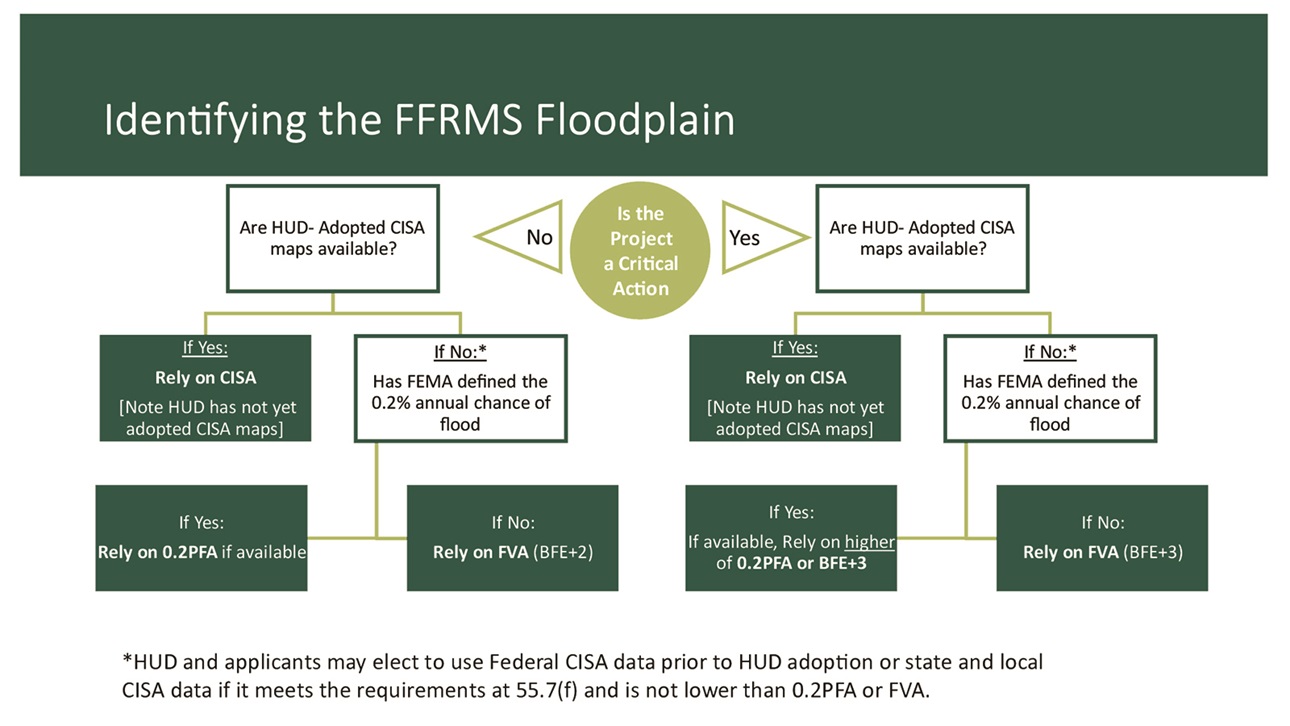What to Know About the New Federal Flood Risk Management System
The Department of Housing and Urban Development released a new Federal Flood Risk Management Standard (FFRMS) in April 2024 that will affect both single-family homes and multifamily properties. Compliance will be required as of Jan. 1, 2025.
For FHA-insured or HUD-assisted multifamily properties, the new FFRMS requires a complicated, three-tiered process for determining the extent of the FFRMS floodplain, with a preference for a climate-informed science approach (CISA). The FFRMS expands the vertical and horizontal floodplain boundaries beyond the special flood hazard area (100-year floodplains). The rule requires more stringent elevation and flood proofing requirements of properties where federal funds are used to develop or provide financing for new construction within the now defined FFRMS floodplain. It also applies to substantial improvement to structures financed through HUD grants, subsidy programs and applicable multifamily programs.

Key points of interest for single-family builders and developers:
- Compliance with new elevation requirements will be required for single-family new construction where building permit applications are submitted on or after Jan. 1, 2025.
- HUD will require single-family homes located in a 100-year floodplain to be elevated 2 feet above base flood elevation to qualify for FHA mortgage insurance.
- The final rule also includes expanded notification requirements for owners, buyers and developers.
Key points of interest for multifamily builders and developers:
- Compliance with the procedures for the FFRMS floodplain management and protection of wetlands is required for FHA-insured and HUD-assisted apartment properties no later than Jan. 1, 2025.
- For HUD-assisted, HUD-acquired and HUD-insured rental properties, new and renewal leases are required to include acknowledgements signed by residents indicating that they have been advised that the property is in a floodplain and flood insurance is available for their personal property, among other information.
- HUD assured borrowers that FHA multifamily mortgage insurance applications submitted Oct. 1, 2024, could be processed under the floodplain regulations that preceded HUD’s FFRMS requirements.
NAHB will continue to monitor this requirement and provide any updates on nahb.org.
Latest from NAHBNow
Dec 17, 2025
House Panel Approves Major Housing PackageIn a move that provides momentum for Congress to enact major housing legislation in early 2026, the House Financial Services Committee this week approved the Housing for the 21st Century Act. This bipartisan housing package takes much-needed steps toward addressing our nation’s critical lack of housing.
Dec 17, 2025
NAHB Weighs In on New WOTUS RuleIn November, the Environmental Protection Agency (EPA) and U.S. Army Corps of Engineers (Corps) announced a proposed updated definition of “waters of the United States” (WOTUS), followed by a 45-day comment period to gather input on the proposed rule. NAHB members and HBA staff provided comments at three public sessions hosted by the agencies to solicit feedback.
Latest Economic News
Dec 16, 2025
Job Market Shows Signs of Cooling in NovemberIn November, job growth slowed, and the unemployment rate rose to 4.6%, its highest level in four years. At the same time, job gains for the previous two months (August and September) were revised downward. The November’s jobs report indicates a cooling labor market as the economy heads into the final month of the year.
Dec 15, 2025
Builder Sentiment Inches Higher but Ends the Year in Negative TerritoryBuilder confidence inched higher to end the year but still remains well into negative territory as builders continue to grapple with rising construction costs, tariff and economic uncertainty, and many potential buyers remaining on the sidelines due to affordability concerns.
Dec 11, 2025
Homeownership Rate Inches Up to 65.3%The latest homeownership rate rose to 65.3% in the third quarter of 2025, according to the Census’s Housing Vacancy Survey (HVS).
